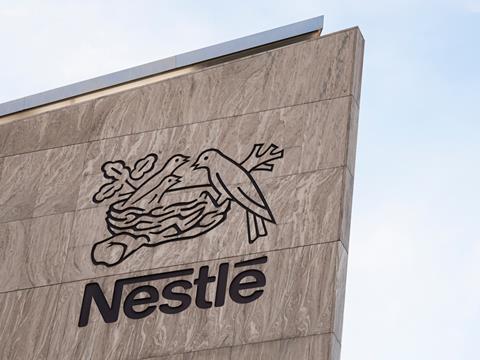
Nestlé has outlined its steps towards its packaging sustainability targets in 2023 – cutting down on single-use plastics, increasing design for recycling, implementing more recycled content, and placing less packaging on the market overall.
Overall, the company sought to place less packaging on the market. Last year’s figure of 320 billion pieces of Nestlé packaging is thought to have reduced 2022’s total by 10 billion pieces, and 2021’s by 24 billion.
In line with its sustainability-minded KPIs, Nestlé emphasizes its mission to cut down on unnecessary packaging, especially that made of virgin plastic. It is a member of the Ellen MacArthur Foundation’s New Plastics Economy initiative, which was founded in 2017 to bring industry players together in voluntary action against the excessive use of plastic packaging.
On that note, it claims to have consumed 814 kilotonnes of virgin plastic in 2023 – a 14.9% reduction compared to the 2018 adjusted baseline of 956 kilotonnes. Now the company estimates that the figure will reach 33% in 2025.
Within the same time frame, it seeks to design 95% of its packaging for recycling. Nestlé aims to follow the design-for-recycling guidelines from such organizations as the Association of Plastics Recyclers (APR), Plastic Recyclers Europe, European PET Bottle Platform (EPBP), The Consumer Goods Forum’s Golden Design Rules, and more.
At the end of 2023, the company claimed to design 83.5% of its packaging for recycling. It also aspires to prevent any disruption to its packaging’s recyclability by phasing several plastic types and additives out of its operations.
86.6% of its packaging was said to be reusable, recyclable, or compostable last year, while 41.5% was made from recycled and/or renewable materials. Nestlé reports that the recycled content in its plastic packaging reached 9.3% – a 1.6% increase from 2022 – and that 0.8% of its packaging is currently reusable.
However, it warns that the availability and cost of alternative materials, alongside the accessibility of waste infrastructure and the development of future regulations, could impact its progress. Such roadblocks have caused concerns that its supply chain could be disrupted, its reputation affected, and regulatory action may become unavoidable.
On the other hand, the Nestlé Institute of Packaging Sciences works with the company’s global R&D network, suppliers, start-ups, and universities in a bid to explore new packaging materials – evaluating their safety and performance on a technical and environmental level.
Currently, it is examining the implementation of high-performing paper barriers; working to implement more recycled content into its materials; transitioning its packaging into mono-material designs; and testing alternative delivery systems for reuse and refill.
Nestlé takes note of Extended Producer Responsibility laws being introduced in 87 jurisdictions last year, with 47 still in draft. It also anticipates the introduction of the Packaging and Packaging Waste Regulation in 2024, and ‘welcome[s] such regulations that drive economies of scale in packaging sustainability and accelerate the development of infrastructure in collection, sorting and recycling’.
A full breakdown of the company’s progress in 2023 is available in its Creating Shared Value and Sustainability Report 2023.
Recently, Nestlé provided a summary of its sustainable packaging progress across the last five years. It was listed among the top quartile brands and retailers group in the Ellen MacArthur Foundation’s Global Commitment, with Nestlé itself claiming to have reduced its virgin plastic packaging by 10.5% and to remain on track to cut its use of virgin plastics by one third by the end of 2025.
Christophe Boussemart and Susanne Kulhanek, representing Nestlé’s Nespresso and Nescafé brands, also spoke to Packaging Europe about its plans for circularity in its single-serve coffee products.
If you liked this story, you might also enjoy:
The Brief: How viable is biorecycling for plastics?
Report: How the top brands are progressing on packaging sustainability
The Brief: Using ocean-bound plastic in packaging – how, why and should we?












No comments yet